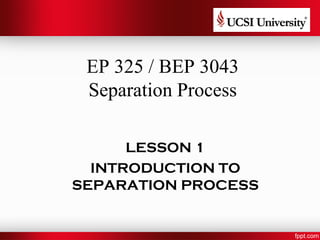Lesson 1 Introduction to Separation Process.pdf
Chemical engineering involves designing processes to transform raw materials into useful products through separation processes. Separation processes are based on differences in physical or physicochemical properties between components in a mixture. There are three main types of separation processes: mechanical separations which separate based on size or density differences; diffusional separations which separate dissolved components using mass transfer; and membrane separations which use semipermeable membranes. Common separation unit operations include distillation, crystallization, filtration and centrifugation. The selection of a separation process depends on factors like the composition and properties of the feed and desired products, the required purity levels, and the energy and equipment needs of the process.

Recommended
Recommended
More Related Content
What's hot
What's hot (20)
Similar to Lesson 1 Introduction to Separation Process.pdf
Similar to Lesson 1 Introduction to Separation Process.pdf (20)
Recently uploaded
Recently uploaded (20)
Lesson 1 Introduction to Separation Process.pdf
- 1. EP 325 / BEP 3043 Separation Process LESSON 1 INTRODUCTION TO SEPARATION PROCESS
- 5. CHEMICAL ENGINEERING ? Chemical engineering is a discipline influencing numerous areas of technology. In broad terms, chemical engineers conceive and design processes to produce, transform and transport materials – beginning with experimentation in the laboratory followed by implementation of the technology in full-scale production.
- 6. Chemical Engineering ??? • Chemical Engineering has to do with industrial processes in which raw materials are changed or separated into useful products.
- 7. Chemical Engineer play a vital role in: • Production and processing of food products • Manufacture of fertilizers, insecticides, pesticides, plastics, synthetic fibers, elastomers drugs, pharmaceuticals, pulp, paper etc. • Processing of petroleum crude, production of synthetic fuels, utilization of biomass, wind, solar, geothermal energy. • Developing methods and equipments to control the release of harmful substances to protect the environment.
- 8. Who is Chemical Engineer ? • Work scope for Chemical Engineer : ✓ Develop, design and engineering both the complete process and the equipment used; ✓ Choose the proper raw materials; ✓ Operate the plants efficiently, safely and economically; ✓ Ensure the products meet the requirements set by the customers. • The professional stature of an engineer depends on skill in utilizing all sources of information to reach practical solutions and problems solving. • Chemical engineers work in four main segments of chemical process industries i.e. R&D, design, production and sales.
- 9. What does a Chemical Engineer do?
- 10. Unit Operations • In most chemical and biochemical production processes, the desired products are in mixture with other components, such as un-converted reactants, by-products and others. • Therefore, separation is needed to attain the products in desired purity and form. • The term “UNIT OPERATION” has been used for a time to refer to the various separation processes for the recovery and purification of products.
- 11. • Common separation processes/ unit operations are: • Separation processes are primarily based on physical means and some on physico-chemical means. Evaporation Distillation Adsorption Crystallization Filtration Centrifugation Spray Drying Membrane Separation
- 12. General Concept & Characteristics of Separation Processes/ Unit Operations • Separation of components in a mixture is always based on the difference in a physical and/or physicochemical properties among the mixture components. • Based on the nature or physical mechanism of separation, various separation processes can be classified into:
- 14. Separation Processes Mechanical Separation Separations based on size and/or density differences of different components in a mixture, for separation of solid-solid or solid-liquid (e.g. sieving, filtration and centrifugation) Diffusional Separations (Mass transfer operations) Separations based on molecular movement towards a favorable phase, for separation of dissolved components (e.g. distillation, absorption, extraction). (Note: Mass transfer is the transfer of solute molecules from one point to another or from one phase to another). Membrane Separations Use of a semipermeable membrane to separate molecules with difference in size or some other properties.
- 16. Mechanical Separations • Mechanical operations that involving particulate solids are: Size reduction Crushing, grinding Mixing Solid-solid, solid-liquid Classification Screening, forth flotation, magnetic separation, jigging, tabling, electrostatic separation, wet classification Solid-fluid separations Filtration, sedimentation, centrifugal separation Gas-solid separations Dust collection, bag filtration, electrostatic precipitation Solid handling Storage feeding, conveying Size enlargement Pelletization, agglomeration, granulation, extrusion
- 17. Factors Affecting the Selection of Separation Process A. Feed conditions 1. Composition, particularly concentration of species to be recovered or separated. 2. Flow rate 3. Temperature 4. Pressure 5. Phase state (solid, liquid, and/or gas) B. Product conditions 1. Required purities 2. Temperature 3. Pressure 4. Phase states C. Property differences that may be exploited 1. Molecular 2. Thermodynamic 3. Transport D. Characteristics of separation operation 1. Ease of scale-up 2. Ease of staging 3. Temperature, pressure and phase- state requirements 4. Physical size limitations 5. Energy requirements
- 18. Sieve Diameter • A sieve diameter is defined as the width of the minimum square aperture through which the particle will pass. • A common sizing device associated with this definition is a series of sieves with square women meshes. • Two sieve standards, i.e., Tyler Standard and American Society for Testing and Materials (ASTM) Standard.
- 20. Prepared by: Dr. Ng Ching Yin ngcy@ucsiuniversity.edu.my